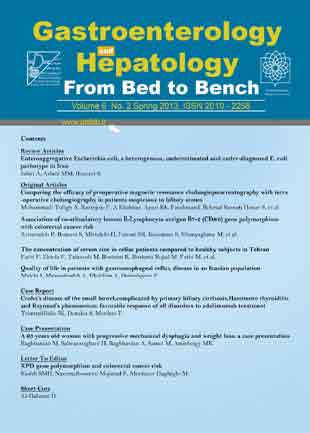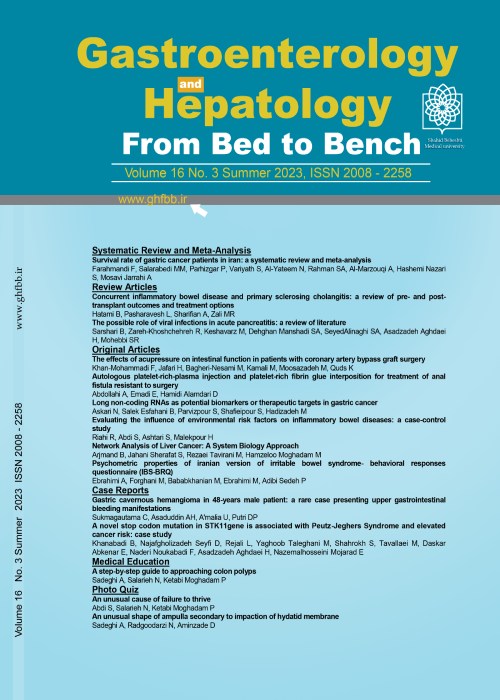فهرست مطالب

Gastroenterology and Hepatology From Bed to Bench Journal
Volume:6 Issue: 2, Spring 2013
- تاریخ انتشار: 1391/12/20
- تعداد عناوین: 9
-
-
Page 71The main features of enteroaggregative Escherichia coli (EAEC) pathogenesis include attachment of bacteria to the intestinal mucosa, production of various toxins and cytotoxins, and stimulation of mucosal inflammation. ‘Virulence’ genes encode these features. Comparison of different EAEC isolates has shown that the virulence gene content of these isolates varies considerably. The heterogeneity of EAEC strains was concluded from the results obtained from the volunteer as well as other studies. Although the underlying mechanism behind the apparent increase in O104:H4 virulence is not known, several bacterial factors have been implicated. In this review, the known virulence factors involved in pathogenesis of EAEC pathotype are summarized.Keywords: Escherichia coli, Enteroaggregative Escherichia coli, E. coli pathotype, Heterogeneity
-
Page 80AimThis study was performed to compare the efficacy of preoperative magnetic resonance cholangiopancreatography (MRCP) and intra-operative cholangiography (IOC) methods in patients suspicious to gall stones.BackgroundAccording to previous studies, it is recommended that common bile duct investigation should be done in order to rule out choledocholithiasis in all patients with symptomatic cholelithiasis. IOC is an invasive procedure with probable complications, it would seem that MRCP could replace the direct cholangiography. Patients andMethodsIn a diagnostic clinical trial, Fifty-nine patients with symptomatic biliary stones or cholecystitis were recruited in this study. The included patients had normal size biliary ducts in sonography but high serum alkaline phosphatase level. Preoperative MRCP and IOC were performed for the patients and the obtained results were analyzed and compared.ResultsThe positive predictive value for IOC was 88% and for MRCP was 43%. The diagnostic accuracy of IOC and MRCP were 98% and 85% respectively, suggesting that IOC is much more diagnostically accurate. There were no significant difference in specificity and sensitivity of these two methods.ConclusionAccording to the results, we can conclude that MRCP may not obviate the need for IOC. The suggestion for routine use of MRCP instead of IOC and as a substitution of that procedure needs further investigations on more patients.Keywords: Magnetic resonance cholangiopancreatography, Intra, operative cholangiography, Gall stone, Cholecystitis, Alkaline phosphatase
-
Page 86AimThis study investigated the role of CD86 +237 G/C polymorphism in intensifying the risk of CRC development.BackgroundColorectal cancer (CRC) is a multi-factorial diseases. Genetic background could affect the susceptibility of individuals to CRC development. CD86 is a co-stimulatory factor on antigen-presenting cells that plays key roles in several cancer related mechanisms such as autoimmunity, transplantation and tumor immunity. Patients andMethodsA total of 300 individuals, 150 known CRC patients and 150 healthy control individuals, were subjected for the study. CD86 rs17281995 single nucleotide polymorphism (SNP) was genotyped using Allelic Discrimination method.ResultsA statistically significant difference was found among CD86 gene polymorphism (r 17281995) and risk of CRC development. The frequency of GG, GC and CC in control subjects was determined as 38%, 57.3% and 4.7% respectively and in CRC subjects were determined as 42%, 85% and 23% respectively. The data shows a significant association between CC genotype (P=0.007) and C allele (P=0.017) of the studied polymorphism and risk of CRC. CC genotype and C allele are also more frequent in female patients when the data is stratified according to gender status.ConclusionOur results suggest that CD86 gene alteration could affect the individual’s risk for developing CRC among Iranian population and could be used as an important prognostic factor associated with risk of CRC.Keywords: CD86, Single nucleotide polymorphism, Colorectal cancer
-
Page 92AimThis study evaluated serum levels of zinc in patient with CD compare to healthy subjects.BackgroundCeliac disease (CD) is characterized by small intestinal malabsorption of nutrients as a consequence of ingestion of wheat gluten. Zinc is an essential trace element that it has vital biological functions. Patients andMethodsSera of 30 celiac cases and 30 healthy normal cohorts as control group were obtained. Atomic absorption spectrophotometer was employed for estimating serum zinc level.ResultsZinc concentrations in patients diagnosed with CD were significantly lower than healthy subjects (75.97±12 compared with 92.83±18, P-value < 0.0001).ConclusionThe result of this study shows that serum zinc concentration is decreased in celiac patients compare to healthy controls. Serum zinc may thus be a marker of CD in adults presenting with gastrointestinal symptoms.Keywords: Celiac disease, Zinc, Atomic absorption spectrophotometer
-
Page 96AimThe study was designed to evaluate quality of life (QOL) for Iranian patients with gastroesophageal reflux disease (GERD).BackgroundGERD is a common and chronic world-wide disease. Impact of GERD on QOL has been studied in many countries, but it has not been studied in Iranian population. Patients andMethodsFifty five patients suffering from GERD and fifty five age and sex matched controls were enrolled. Patient inclusion criteria were based on clinical and endoscopic findings. All other major diseases having an impact on QOL had been excluded. All the subjects were asked to fill the validated translation of SF-36 and GHQ-28 questionnaires. Results of the SF-36 questionnaire was analyzed directly and after correction for the results obtained from the GHQ-28 tool.ResultsGERD patients had lower QOL scores than controls. Correction of the results based the findings of GHQ-28 questionnaire did not change the results.ConclusionQOL in GERD patients is impaired and should be considered in clinical practice and implementing research studies upon GERD patients.Keywords: Gastroesophageal Reflux Disease, Quality of Life, Iran, SF, 36, Mental health
-
Page 101We describe the case of a male patient suffering from long-lasting Crohn’s disease of the small bowel who developed thyroiditis Hassimoto, Raynaud’s phenomenon, and primary biliary cirrhosis, during the course of the underlying bowel disease. It is not clear whether these co-morbidities appeared coincidentally, or because they share some common immunopathogenetic mechanisms. In this patient, Crohn’s disease favorably responded to the treatment with an anti- TNF-α agent (adalimumab). The serum titers of antimitochondrial antibodyies and cholestatic enzymes considerably reduced during the 3-year treatment with the biologic agent. Raynaud’s phenomenon, also, completely disappeared. Bearing in mind the possible involvement of TNF-α in the pathogenesis of primary biliary cirrhosis, it could be argued that the clinical and laboratory improvement of liver disease, as well as the reduction in serum titers of antimitochondrial antibodies, might be due to the anti-TNF-α action of adalimumab. We suggest that it would be worth further investigating the role of biologic agents in the treatment of patients with primary biliary cirrhosisKeywords: Crohn's disease, Primary biliary cirrhosis, Extraintestinal manifestations, Inflammatory bowel disease, Infliximab
-
Page 106When considering a patient with dysphagia, an attempt should be made to determine whether the patient has difficulty only with solid boluses (suggestive of mechanical dysphagia) or with liquids and solids (suggestive of a motility dysphagia). Lesions such as an oesophageal tumor and external pressure effect from a lung tumor or aberrant vessel can lead to mechanical dysphagia. Endoscopy and / or a barium swallow are helpful in identifying the anatomical disarrangement. In this study a patient with progressive mechanical dysphagia is presented that finally diagnosed by as Lung Squamous Cell Carcinoma. There were no respiratory symptoms. Diagnosis was made by a computerized tomography scan of the thorax, bronchoscopy and bronchial biopsy.Keywords: Dysphagia, Lung, Squamous Cell Carcinoma
-
Page 112


